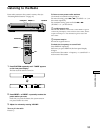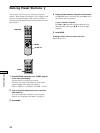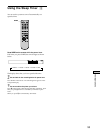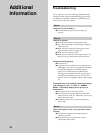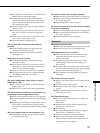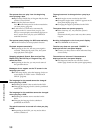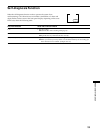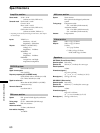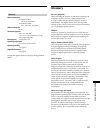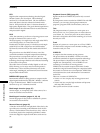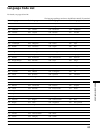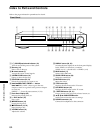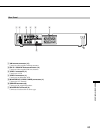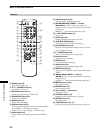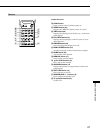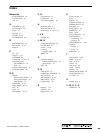
61
Additional Information
General
Power requirements
European models:
230 V AC, 50/60 Hz
Australian models:
220 – 240 V AC, 50/60 Hz
Power consumption
68 W
Dimensions (approx.)
355 × 70 × 365 mm
(15 × 2
7
/8 × 14
3
/8 inches) (w/h/d)
incl. projecting parts
Mass (approx.) 3.8 kg (8 lb 6 oz)
Operating temperature
5˚C to 35˚C (41˚F to 95˚F)
Operating humidity
5 % to 90 %
Supplied accessories
See page 7.
Design and specifications are subject to change without
notice.
Glossary
Bit rate (page 40)
Value indicating the amount of video data compressed in
a DVD per second. The unit is Mbps (Mega bit per
second). 1 Mbps indicates that the data per second is
1,000,000 bits. The higher the bit rate is, the larger the
amount of data. However, this does not always mean that
you can get higher quality pictures.
Chapter
Sections of a picture or a music piece on a DVD that are
smaller than titles. A title is composed of several chapters.
Each chapter is assigned a chapter number enabling you
to locate the chapter you want.
Digital Cinema Sound (DCS)
This is the generic name of the surround sound produced
by digital signal processing technology developed by
Sony. Unlike previous surround sound fields mainly
directed at the reproduction of music, Digital Cinema
Sound is designed specifically for the enjoyment of
movies.
Dolby Digital
This sound format for movie theaters is more advanced
than Dolby Pro Logic Surround. In this format, the rear
speakers output stereo sound with an expanded
frequency range and a subwoofer channel for deep bass is
independently provided. This format is also called “5.1”
because the subwoofer channel is counted as 0.1 channel
(since it functions only when a deep bass effect is needed).
All six channels in this format are recorded separately to
realize superior channel separation. Furthermore, since
all the signals are processed digitally, less signal
degradation occurs. The name “AC-3” comes from the
fact that it is the third audio coding method to be
developed by the Dolby Laboratories Licensing
Corporation.
Dolby Pro Logic Surround
As one method of decoding Dolby Surround, Dolby Pro
Logic Surround produces four channels from two-channel
sound. Compared with the former Dolby Surround
system, Dolby Pro Logic Surround reproduces left-to-right
panning more naturally and localizes sounds more
precisely. To take full advantage of Dolby Pro Logic
Surround, you should have one pair of rear speakers and
a center speaker. The rear speakers output monaural
sound.



